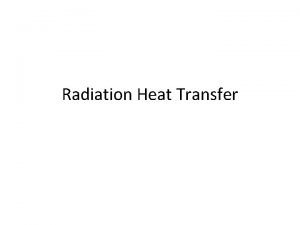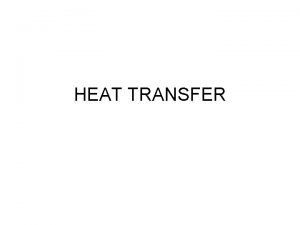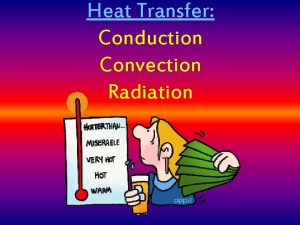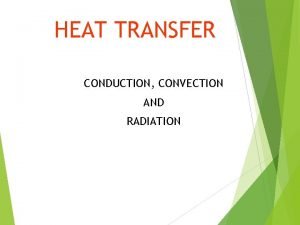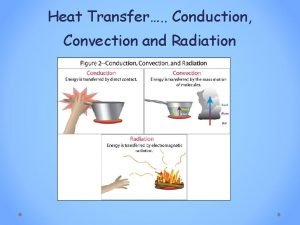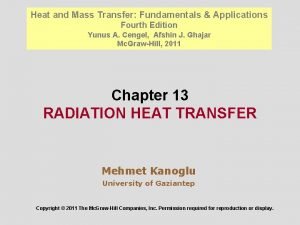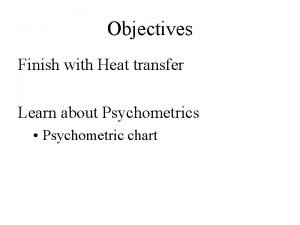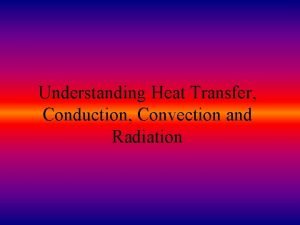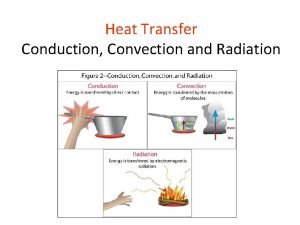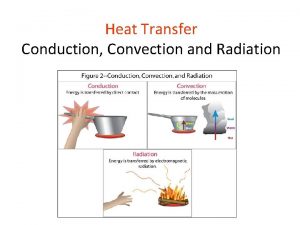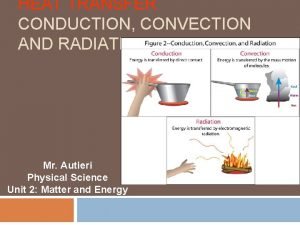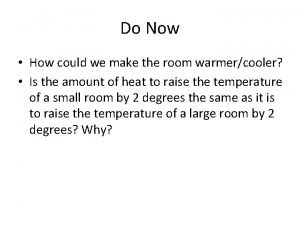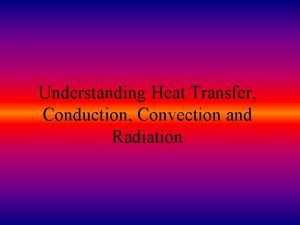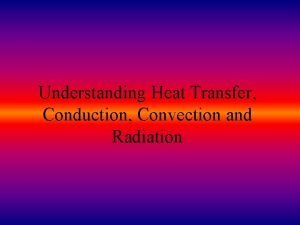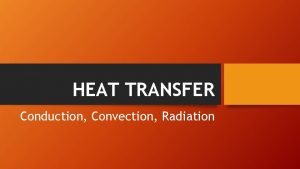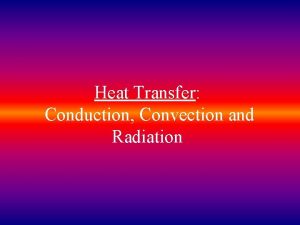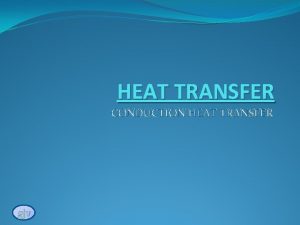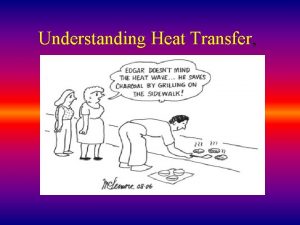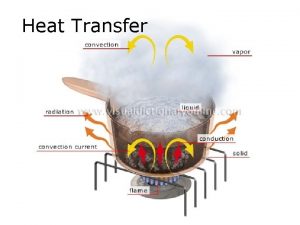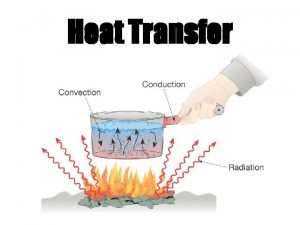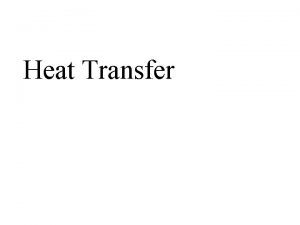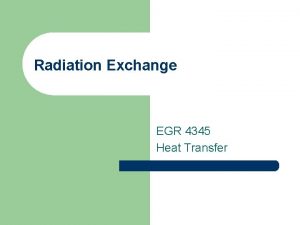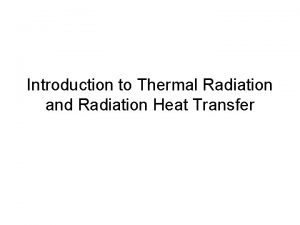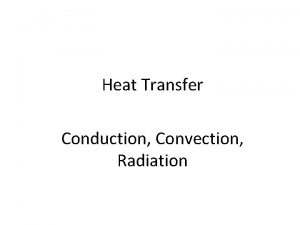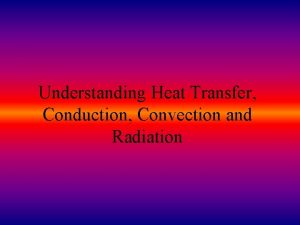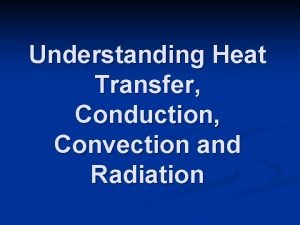Radiation Heat Transfer The third method of heat



























- Slides: 27

Radiation Heat Transfer

The third method of heat transfer How does heat energy get from the Sun to the Earth? There are no particles between the Sun and the Earth so it CANNOT travel by conduction or by convection. ? RADIATION

How can we relate our new understanding to the greenhouse effect?

Electromagnetic Spectrum • Thermal or heat radiation is the transfer of energy basically by infra-red waves. These waves are part of the electromagnetic spectrum

UV Radiation • The most lethal type of radiation is ultraviolet radiation with a wavelength of 260 nm. This is the wavelength most actively absorbed by DNA. • It is useful for disinfecting surfaces, air and liquids.

• Unfortunately, this type of radiation does not penetrate dirt, glass, water, or other substances. If a surface is dusty, then complete inactivation of all microorganisms may not occur. • Due to its poor penetration, UV radiation is only useful for disinfecting outer surfaces.

Radiation travels as waves of photons that release energy when absorbed. All objects above 0° K release radiation, and its heat energy value increases to the 4 th power of its temperature.


Incoming Solar Radiation (Insolation) At the top of the atmosphere

Electromagnetic Spectrum Solar radiation has peak intensities in the shorter wavelengths, dominant in the region we know as visible, but extends at low intensity into longwave regions.

Incoming Solar Radiation Solar radiation is scattered and reflected by the atmosphere, clouds, and earth's surface, creating an average albedo of 30%. Atmospheric gases and clouds absorb another 19 units, leaving 51 units of shortwave absorbed by the earth's surface.

Albedo is the fraction of Sun’s radiation reflected from a surface. It is quantified as the proportion, or percentage of solar radiation of all wavelengths reflected by a body or surface to the amount incident upon it. An ideal white body has an albedo of 100% and an ideal black body, 0%. Visually we can estimate the albedo of an object’s surface from its tone or color. This method suggests that albedo becomes higher as an object gets lighter in shade.

Albedo of the Earth's terrestrial surface as measured by the TERRA satellite. Data collected from the period April 7 -22, 2002. (Source: NASA Earth Observatory).

Longwave & Shortwave Radiation The hot sun radiates at shorter wavelengths that carry more energy, and the fraction absorbed by the cooler earth is then re -radiated at longer wavelengths, as predicted by Wein's law.

INFRARED WAVES Heat can move by travelling as infrared waves. These are electromagnetic waves, like light waves, but with a longer wavelength. This means that infrared waves act like light waves: l They can travel through a vacuum. l They travel at the same speed as light – 300, 000 m/s. l They can be reflected and absorbed. Infrared waves heat objects that absorb them and so can be called thermal radiation.

ABSORBING THERMAL RADIATION Infrared waves heat objects that absorb (take in) them. Some surfaces are better at absorbing thermal radiation than others – good emitters are also good absorbers. worst emitter best emitter matt black white best absorber silver worst absorber Matt black surfaces are the best absorbers of radiation. Shiny surfaces are the worst emitters because they reflect most of the radiation away. Why are solar panels that are used for heating water covered in a black outer layer?

Radiation travels in straight lines True/False Radiation can travel through a vacuum True/False Radiation requires particles to travel True/False Radiation travels at the speed of light True/False

Emission experiment Four containers were filled with warm water. Which container would have the warmest water after ten minutes? Dull metal Shiny black Dull black The _____ shiny metal container would be the warmest after ten minutes because its shiny surface reflects heat radiation _______ back into the container so less is lost. The dull black container would be the coolest because it is the best at _______ emitting heat ____ radiation.

Absorption experiment Four containers were placed equidistant from a heater. Which container would have the warmest water after ten minutes? Dull metal Shiny black Dull black dull black container would be the warmest after ten minutes because its The _____ radiation the best. The shiny metal container would be the surface absorbs heat _________ absorbing heat radiation. coolest because it is the poorest at _____

Radiation Heat Transfer • e = emissive power • G = total irradiation • J = total radiosity e = emissivity a=e In general: a = absorptivity r = reflectivity t = transmissivity Opaque material:


The Black Body A black body is defined as a body that absorbs all radiation that falls on its surface. Actual black bodies don't exist in nature - though its characteristics are approximated by a hole in a box filled with highly absorptive material. The emission spectrum of such a black body was first fully described by Max Planck.

The radiation energy per unit time from a blackbody is proportional to the fourth power of the absolute temperature and can be expressed with Stefan-Boltzmann Law as q = σ T 4 A (1) where q = heat transfer per unit time (W) σ = 5. 6703 10 -8 (W/m 2 K 4) - The Stefan-Boltzmann Constant T = absolute temperature Kelvin (K) A = area of the emitting body (m 2) Example - Radiation from the surface of the Sun If the surface temperature of the sun is 5800 K and if we assume that the sun can be regarded as a black body the radiation energy per unit time can be expressed by modifying (1) like q / A = σ T 4 = (5. 6703 10 -8 W/m 2 K 4) (5800 K)4 = 6. 42 107 W/m 2

Gray Bodies and Emissivity Coefficients For objects other than ideal blackbodies ('gray bodies') the Stefan-Boltzmann Law can be expressed as q = ε σ T 4 A (2) where ε = emissivity of the object (one for a black body) For the gray body the incident radiation (also called irradiation) is partly reflected, absorbed or transmitted.

The emissivity coefficient - ε - for some common materials can be found in the table below. Note that the emissivity coefficients for some products varies with the temperature. As a guideline the emmisivities below are based on temperature 300 K. Surface Material Emissivity Coefficient -ε- Alloy 24 ST Polished 0. 09 Aluminum Commercial sheet 0. 09 Asphalt Cadmium Concrete 0. 93 0. 02 0. 85 Concrete, rough 0. 94 Concrete tiles 0. 63 Cotton Cloth 0. 77 Ice smooth 0. 966 Water 0. 95 - 0. 963 http: //www. engin eeringtoolbox. com /emissivitycoefficientsd_447. html

Radiation Heat Transfer • Black Body – absorptivity = a=1 – emissivity = e=1 – ideal emissive power = eb • Gray Body – absorptivity < 1 – emissive power<1

Radiative Heat Transfer Consider the heat transfer between two surfaces, as shown in Figure. What is the rate of heat transfer into Surface B? To find this, we will first look at the emission from A to B. Surface A emits radiation as described in This radiation is emitted in all directions, and only a fraction of it will actually strike Surface B. This fraction is called the shape factor, F.
 Four containers were filled with warm water
Four containers were filled with warm water Sunlight melts a wax crayon left outside.
Sunlight melts a wax crayon left outside. Radiation heat transfer examples
Radiation heat transfer examples What is heat transfer conduction convection and radiation
What is heat transfer conduction convection and radiation Radiation example
Radiation example Does radiation travels in straight lines
Does radiation travels in straight lines Define radiation shield
Define radiation shield Radiation heat transfer coefficient
Radiation heat transfer coefficient Radiation heat transfer
Radiation heat transfer Types of heat transfer
Types of heat transfer How does heat move
How does heat move Convection example at home
Convection example at home Heat transfer by conduction convection and radiation
Heat transfer by conduction convection and radiation Mount and hume classification
Mount and hume classification Odontoclasia definition
Odontoclasia definition Common household chores method of heat transfer
Common household chores method of heat transfer Method of heat transfer
Method of heat transfer Which is the best surface for reflecting heat radiation
Which is the best surface for reflecting heat radiation How is thermal energy transferred?
How is thermal energy transferred? Because of convection, the warmest air in a room _____.
Because of convection, the warmest air in a room _____. Which is the best surface for reflecting heat radiation
Which is the best surface for reflecting heat radiation Traps heat shields the surface from harmful radiation
Traps heat shields the surface from harmful radiation Which is the best surface for reflecting heat radiation
Which is the best surface for reflecting heat radiation Is a disturbance that transfers energy from place to place
Is a disturbance that transfers energy from place to place Plain alidade
Plain alidade What is the purpose of symposium
What is the purpose of symposium Third angle projection method
Third angle projection method Glass box approach
Glass box approach
